Posts Tagged: disease
Rust on Raspberry
Yellow rust on raspberry has been a common issue of concern for growers and PCA's this past week, very likely this has been spurred on by the wet weather of this past winter.
Recommendations for management available at the UC IPM guidelines
http://ucipm.ucdavis.edu/PMG/r71101111.html
The pictures below are of what some of this rust manifests itself as. Viewing the leaf from the top, one sees an array of darker spots over a lighter background of the chlorotic leaf (not diagnostic, nor do I make any pretensions that this is being caused by the rust disease). Turning the leaf over, one can see the masses of pustules growing at these very spots.
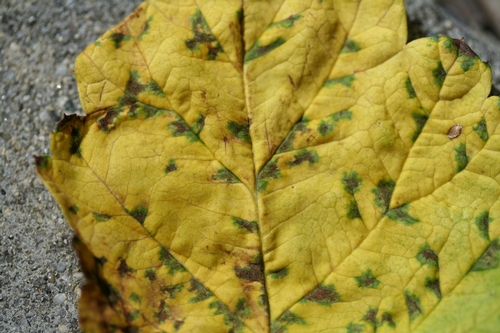
Yellow rust affected leaf; top view.
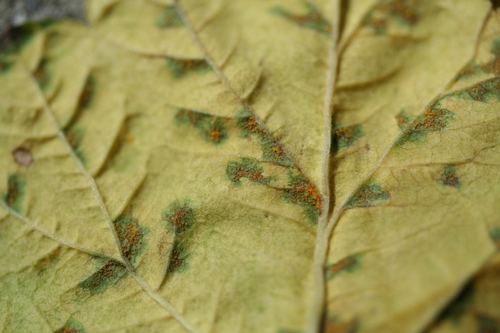
Yellow rust on raspberry leaf, bottom view.
Sulfur and Plant Disease
The element sulfur (S) has a large role in the management of plant disease. Growers are familiar with the biocidal formulations of sulfur, being elemental sulfur, sulfides, thiosulfate and fumigants like dimethyldisulfide (DMDS) and of course then we have sulfur dioxide which has been used as a postharvest preservative for dried fruits and vegetables.
However, beyond these outright biocidal effects we get from use of sulfur as a fungicide, there is also significant literature concerning the indirect effects of sulfur nutrition on reinforcing a plant's ability to inhibit and resist disease. Known as “Sulfur Induced Resistance” this is how one should frame the role of sulfur incorporated as a nutrient in plant response to disease.
There could be something to this. Work has been done showing that higher rates of S fertility affected infection rates and severity of fungal disease in oilseed rape and stem canker of potato. While informative, it is significant that the results of the former were achieved by sulfur additions to a field that was deficient.
How would sulfur induce resistance or inhibit disease in a plant? Sulfur goes to many places, including the amino acids acids cysteine and methionine, which are in 99% of proteins found in a plant. Findings cited by the chapter report that sulfur deficiency in the plant result in lower protein bound cysteine and free cysteine, which as the precursor to all relevant sulfur containing metabolites must have something to do with the ability to resist or inhibit disease.
Sulfur also goes to non-protein reservoirs in the plant, one of the main ones being glutathione. Glutathione, known as a phytoalexin because it is not formed prior to disease incursion, nevertheless accumulates rapidly after pathogen attack. It is involved in detoxifying signals necessary for fungal growth and could also be serving as a messenger to carry information to yet unaffected plant cells.
Phytoanticipins, in contrast to phytoalexins, are molecules in the plant which are preformed antibiotics- i.e. the plant produces them whether or not there is disease. Glucosinolates (of which our well known isothiocyanates are a cleaved product), on which sulfur plant nutrition has a strong influence, are one of these antibiotic phytoanticipins. Interestingly, low concentrations of glucosinolates don't necessarily equate with higher disease susceptibility, making them more of a qualitative defense for the plant.
Bottom line: The role of sulfur in disease resistance and inhibition in plants is a very important one, but it's a pretty sure thing that these systems function perfectly well in sulfur sufficient soils, which describe pretty well every one in the Pajaro and Salinas Valleys. As such, while the value of sulfur as a foliar fungicide is indisputable for certain diseases, I am not seeing the value of pursuing sulfur work experimentally as a soil disease mitigant.
The above is a summary of some of the aspects of Chapter 8: Sulfur in Plant Disease from “Mineral Nutrition and Plant Disease” edited by Lawrence Datnoff, Wade Elmer and Don Huber.
A Brief Overview of the Role of Manganese in Mitigating Soil Disease in Cultivated Plants including Strawberry.
I spent some time these past few days reviewing a chapter of the excellent publication Mineral Nutrition and Plant Disease. This book is a review of the scientific literature, and while we should not see any of this as recommendations for crop production practice, it does give us plenty to think about as far as what direction we can go experimentally:
Manganese (Mn) has a consistent record in the scientific literature as reducing vascular diseases in crop plants caused by soil pathogens such as Verticillium and Fusarium. Physiologically, this makes sense because of the role that manganese plays in the production of phenolic compounds, phytoalexins and other plant defense mechanisms.
An increase then in the amount of Mn applied to the soil (foliar applied does not work well, since Mn does not move downwards in the plant to the roots) seems to be a straightforward approach in obtaining the disease reducing qualities of this element into the plant. For example, one study (Dutta and Bremner, 1981), achieved greatly reduced Verticillium wilt by dipping tomato roots in a Mn solution before transplanting.
However, there are other strategies to increase plant tissue Mn, especially in the soil right around the roots. Lowering the pH of that soil through the use of ammonium fertilizers such as ammonium sulfate (ammonium acidifies more than nitrate), has reduced Verticillium wilt from moderately infested soils in eggplant (Elmer and Ferradino, 1994), and the combination of a rotation with oats with ammonium fertility (Elmer and LaMondia, 1999) has been shown to double the Mn tissue concentration in subsequent plantings of strawberry and reduce black root rot incidence (but not, unfortunately, increase plant growth or yield).
Again, some of this might be worth a look experimentally in strawberry on the Central Coast.
Several of the papers mentioned in the text above are available online – links provided below.
1. Dutta, B.K. and Bremner, E. 1981. Trace elements and plant chemo therapeutants to control Verticillum albo-atrum wilt. Z. Pflanzenkankh. Pflanzenschutz 88:405-412
2. Elmer and LaMondia. 1994. Comparison of Ammonium Sulfate and Calcium Nitrate Fertilization Effects on Verticillium Wilt on Eggplant. Plant Disease 78: 811-816 https://www.apsnet.org/publications/PlantDisease/
3. Elmer W.H. and LaMondia, J. A. 1999. Influence of ammonium sulfate and rotation crops on strawberry black root rot. Plant Disease 83: 119-123. http://apsjournals.apsnet.org/doi/pdf/10.1094/PDIS.1999.83.2.119
A Review on Anthracnose Disease Caused by Colletotrichum acutatum in Strawberry
While anthracnose has been a very minor problem on Central Coast strawberry up to now, this disease is known to be most severe when there are winter and spring rains. In late 2015 and early 2016, anthracnose cases have been a concern for some growers in southern California. Therefore a brief review of anthracnose would be appropriate and is presented here.
Symptoms: The anthracnose pathogen is rather unique in that this fungus can infect virtually all parts of the strawberry plant, though some infections are more important than others. Most symptoms on above-ground parts of plants consist of dark, elongated lesions. If warm, wet field conditions are present, such lesions will contain orange masses of the pathogen's spores. For below-ground parts, symptoms consist of decayed, darkened roots, discoloration of the internal crown tissue, and wilting and collapsing plants; therefore, the root and crown phases of anthracnose will closely resemble symptoms caused by Phytophthora and other soilborne pathogens. Table 1 lists the major symptoms on strawberry.
Table 1. Anthracnose symptoms and signs on strawberry
|
Strawberry tissue |
Symptoms |
Orange spore masses?
|
|
root |
discolored, rotted roots, causing leaves to wilt |
no |
|
crown |
discolored internal crown, causing leaves to wilt |
no |
|
leaf petiole |
dark brown, elongated lesions |
yes |
|
leaf blade |
gray to brown spots |
yes |
|
runner |
dark brown, elongated lesions |
yes |
|
flower peduncle (stem) |
dark brown, elongated lesions |
yes |
|
flower |
discolored tissue, causing flower to shrivel |
sometimes |
|
fruit |
brown, oval to round, firm, dry sunken spots |
yes |
Pathogen: Anthracnose on strawberry in California is primarily caused by Colletotrichum acutatum, though strawberry is also host to additional Colletotrichum species. C. acutatum is found worldwide on strawberry and many other crop and weed hosts. Some of these other hosts include the following: almond, celery, delphinium, pepper, pine tree, tomato, walnut, zinnia, chickweed, fiddleneck, vetch. It is unclear to what extent C. acutatum from non-strawberry hosts can infect and cause significant damage to strawberry. For example, researchers have found that strawberry isolates of C. acutatum are more aggressive and damaging to strawberry than isolates from other hosts. Therefore, C. acutatum is likely composed of diverse strains or sub-types that have some degree of host specificity or preference.
Disease Cycle: Colletotrichum acutatum is not a true soil inhabitant and cannot survive in the soil indefinitely. Studies show that this pathogen, under California conditions, can remain viable in the soil for about 9 months without a strawberry host. Based on this limited survival capability and the pattern and sporadic distribution of disease when it does develop, disease occurrence in fumigated fields is primarily due to infested or diseased strawberry transplants. The disease is favored by moderate temperatures (60 to 85 degrees F) and wet, humid weather. The development and spread of spores is strongly dependent on sprinkler irrigation and rain. The spores form in a sticky matrix and will only spread through physical contact (such as from passing equipment that brushes against the lesions) or splashing water. Therefore, anthracnose disease on strawberry fruit is very rare unless rains occur during the fruit production season.
Pre-plant control measures: Pre-plant applied soil fumigants likely will reduce most of any remaining inoculum in the soil. However, information is limited on how well non-methyl bromide containing treatments reduce soilborne inoculum. Hot water treatment of transplants can reduce the level of anthracnose. Prior to planting, dipping transplants in fungicides (such as Abound and Switch) can also reduce anthracnose. Such treatments need to be done carefully; damage has occurred to transplants dipped in Switch but not immediately planted. However, plant injury was not observed in a Ventura County experiment in which plants were dipped for 2-3 minutes in Switch (5 oz/100 gal) and then planted within 30 minutes. If considering plant dips, consult with fungicide product representatives and UC extension personnel.
Post-plant control measures: Avoid the use of overhead sprinklers. During the production growing season, if rainy weather occurs and there are concerns with or detections of anthracnose, foliar sprays are warranted. Captan, Abound, and Switch are registered and are effective in reducing disease. Note that these are protectant materials only and need to be applied prior to infection. If foliar lesions are abundant, keep in mind that passing equipment can spread spores to previously uninfected plants and blocks. If feasible, remove diseased fruit and collapsing or dead plants since these plant parts are sources of secondary inoculum.
In most cases, accurate identification of anthracnose requires laboratory analysis and testing. Before using any fungicides, check with your local Agricultural Commissioner's Office and consult product labels for current status on registration, restrictions, and use. For additional information on anthracnose and other strawberry diseases, consult the UC IPM Pest Management Guidelines:
http://ucipm.ucdavis.edu/PMG/r734101011.html
(English and Spanish versions are available).
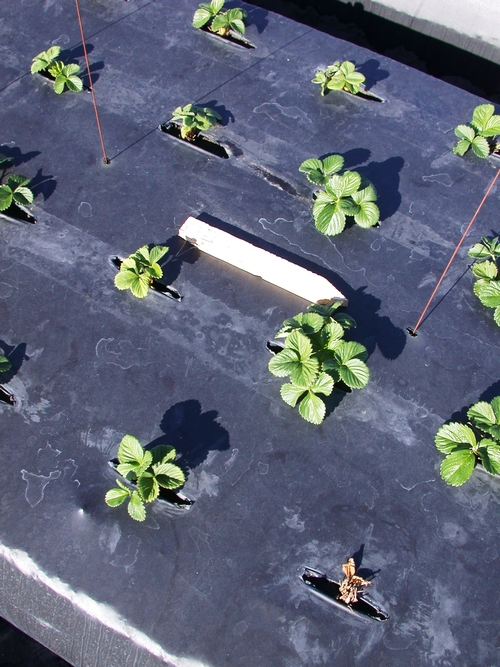
Poor growth of C. acutatum inoculated plants with some decline and mortality 6 wks after planting. Photo Oleg Daugovish, UCCE.
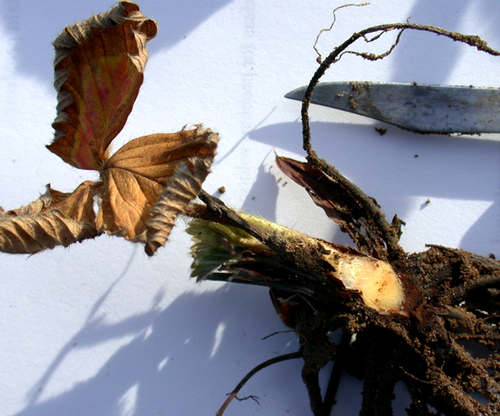
Early season die-back on C. acutatum infected strawberry. Photo Oleg Daugovish, UCCE.
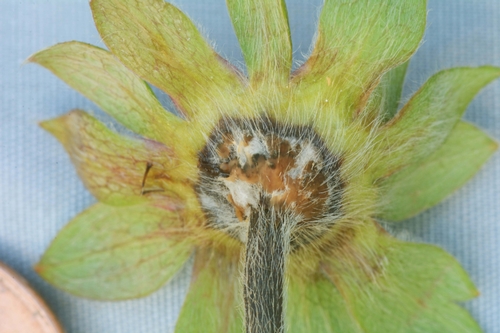
Strawberry blossom infected with C. acutatum. Photo, Steven Koike, UCCE.
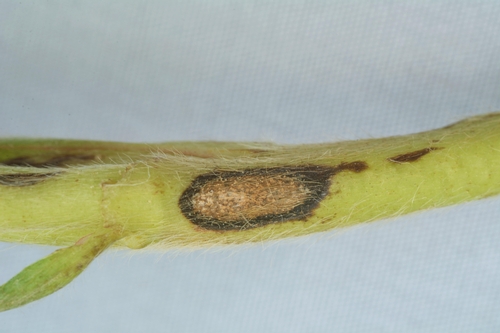
Anthracnose lesion on stem of strawberry. Photo Steven Koike, UCCE.
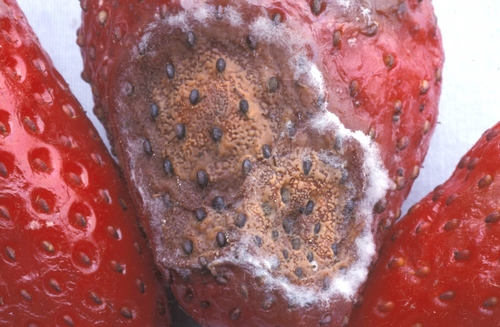
Advanced anthracnose lesion on strawberry fruit. Photo Steven Koike, UCCE.
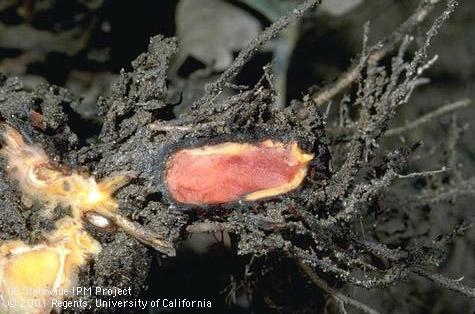
Discolored crown of strawberry caused by C. acutatum. Photo UC IPM.
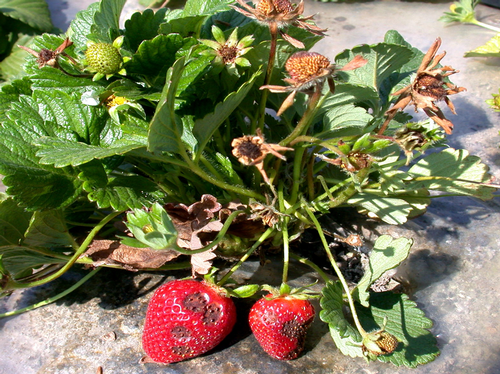
Late-season symptoms on C. acutatum infected strawberry. Photo Oleg Daugovish, UCCE.
Unusual Flare-up of Leaf Blotch Disease of Strawberry
Leaf blotch disease, caused by Zythia fragariae, is a very minor foliar disease of strawberry in California. Usually the disease occurs in late winter/early spring when there are sufficient rains to activate the fungus and spread the spores. Once the winter season rains have ceased, the disease subsides before the development of much fruit. Because of the drought, leaf blotch was generally not observed or reported during the late winter/early spring of this season.
However, an unusual flare-up of leaf blotch is currently developing in some fields in the central coast. Because of the lack of rainfall and build up of salts in the soil, some growers used sprinklers in the early spring to alleviate salt buildup and reduce subsequent stress of the strawberry transplants. It appears that in some cases, the sprinkler irrigations have enabled Zythia to develop and cause typical leaf blotches. Symptoms consist of tan to gray leaf lesions that commonly (though not exclusively) develop along the margin or edge of the leaflets (Photo 1). Leaf blotches are irregular in shape and may be surrounded by a purple border. These affected areas tend to grow fairly large; they can expand and cover from 1/4 to 1/2 of the leaflet surface. A key diagnostic feature of leaf blotch is the presence of tiny, brown to black, fungal fruiting bodies in the gray blotches (Photos 2 and 3). These fruiting bodies produce tiny spores (Photo 4) that are readily spread by splashing water.
A related development is the formation of brown to tan lesions on the calyx tissue of strawberry fruit (Photo 5). Calyx lesions appear to be associated with plants having the leaf symptoms. In some cases, the Zythia fruiting bodies are present in the calyx lesions and appear as darker brown, circular to oblong structures (Photo 6). However, fruiting bodies are not always present; since there are other physiological or environmental factors that can result in damage to fruit calices, care should be taken when diagnosing this problem.
UC Cooperative Extension does not have efficacy data for fungicide use for leaf blotch; therefore, we do not recommend or suggest the use of fungicides. Researchers in other areas (Europe) have determined that the following materials have good effectiveness against the leaf blotch pathogen: Pristine, Quadris, Rally. Switch also reduced disease but was less effective. This April occurrence of leaf blotch following sprinkler irrigations is a good reminder of how environmental conditions are essential for the development of plant diseases. This leaf blotch situation may continue to be present if any late April rains fall.
There are fungicides mentioned for management of leaf blotch disease in this article. As always, before using any of these products, check with your local Agricultural Commissioner's Office and consult product labels for current status of product registration, restrictions, and use information.
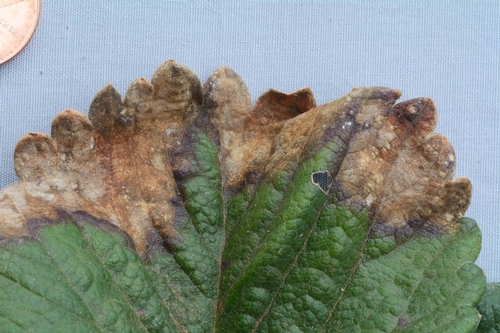
Photo 1. Leaf blotch is characterized by irregularly shaped, gray to brown leaf lesions. Photo: Steven Koike, UCCE.
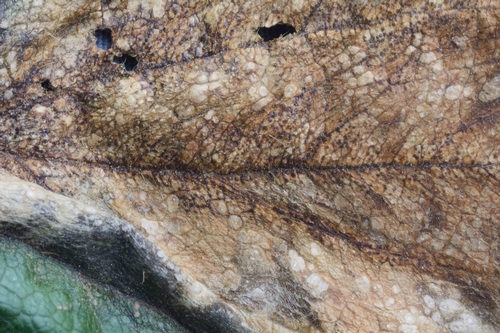
Photo 2. Fungal fruiting bodies are usually present in the leaf blotch lesions. Photo: Steven Koike, UCCE.
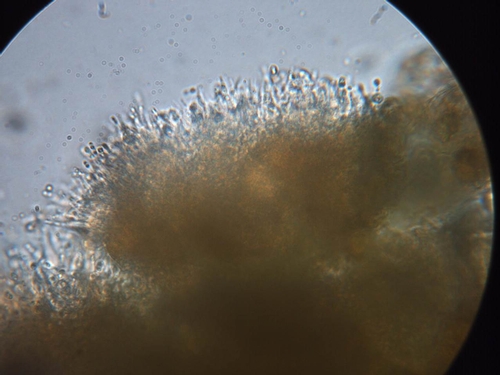
Photo 3. Close up photograph of a portion of the Zythia fruiting body; each upright spike produces an infective spore. Photo: Steven Koike, UCCE.
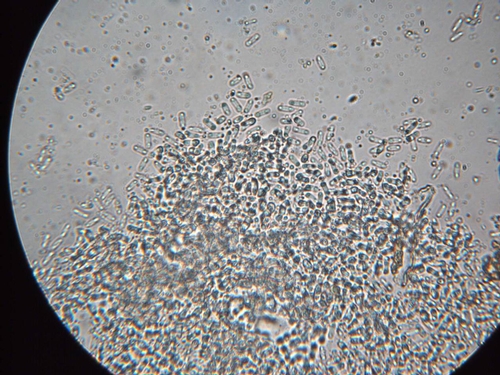
Photo 4. Zythia produces tiny spores that are spread by splashing water. Photo: Steven Koike, UCCE.
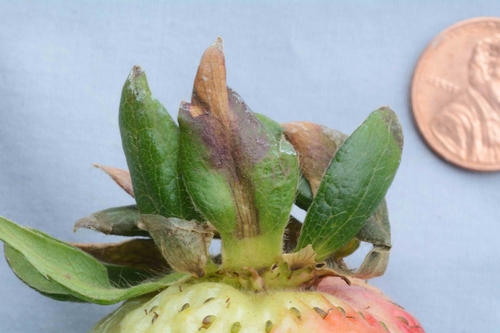
Photo 5. In some cases, it appears that Zythia is causing lesions on fruit calyx tissue. Photo: Steven Koike, UCCE.
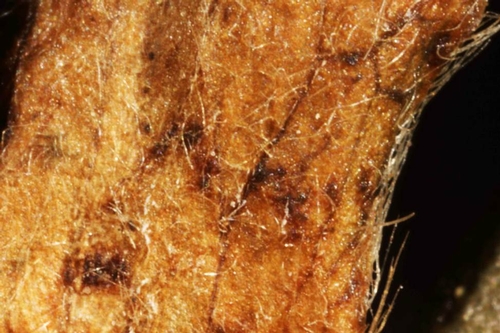
Photo 6. Fruiting bodies in strawberry calyx tissues confirm the presence of Zythia. Photo: Steven Koike, UCCE.

